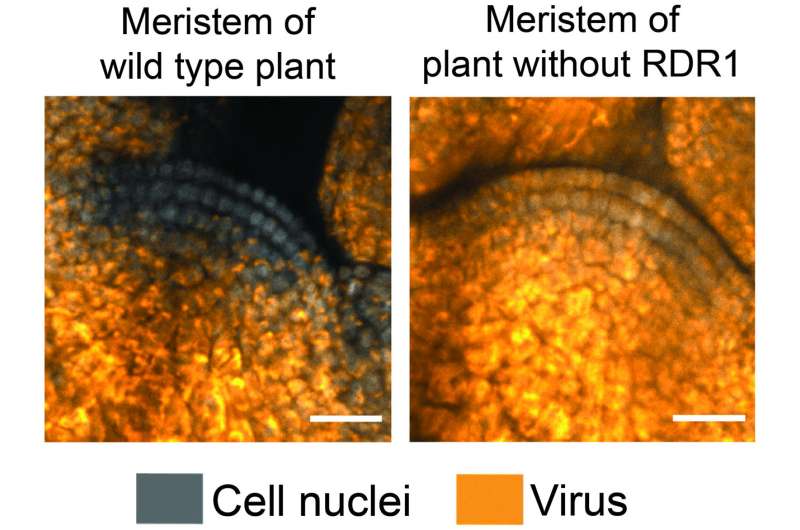This article has been reviewed according to Science X's editorial process and policies. Editors have highlighted the following attributes while ensuring the content's credibility:
fact-checked
peer-reviewed publication
proofread
Biologists find salicylic acid and RNA interference mediate antiviral immunity of plant stem cells

Viruses are a threat to all organisms, including plants. A small group of plant stem cells, however, successfully defends itself from infection.
Marco Incarbone, now at MPIMP Golm, Gabriele Bradamante and their co-authors at the Gregor Mendel Institute of Molecular Plant Biology (GMI) uncovered that salicylic acid and RNA interference mediate this antiviral immunity of plant stem cells. The findings were published in PNAS on October 12.
Plant viruses threaten the health of their hosts, can spread swiftly and globally, and challenge agricultural productivity. When viruses successfully infect plants, the infection often spreads through the entire organism. Well, not entirely: One small group of indomitable cells still holds out, the stem cells within the shoot tip. This small group of cells generates all plant tissues above ground, including the next plant generation, and for reasons still poorly understood, viruses are unable to proliferate in these cells.
Marco Incarbone, previously a postdoctoral researcher in the group of Ortrun Mittelsten Scheid at the Gregor Mendel Institute of the Austrian Academy of Sciences (GMI) and now a group leader at the Max Planck Institute of Molecular Plant Physiology in Germany sought to uncover the molecular bases of how stem cells in the shoot apical meristem fight off viruses together with Ph.D. student Gabriele Bradamante and other GMI group members.
To understand the strong antiviral defenses of this special group of cells, Incarbone, Bradamante and colleagues first established a screening platform. "We developed high-throughput microscopy techniques that allowed us to study many Arabidopsis meristems at several timepoints after the viral infection, to give a temporal dimension to our exploration," Incarbone explains.
Using this dynamic, semi-quantitative approach, the researchers observed that Turnip mosaic virus—their plant model virus of choice—spreads in their model plant Arabidopsis thaliana, arrives at the stem cells within the shoot tip , and even enters these cells, but is then quickly excluded. "Surprisingly, these cells are really good at driving the virus out."
Past work on a close relative of tobacco had provided clues that RNA interference—a pathway that inhibits virus proliferation in plants and many animals—plays a role in virus exclusion in plants. In the search for the defense's molecular bases, the researchers therefore screened Arabidopsis mutant plants that miss certain components of the RNA interference pathway. In addition, they studied plants deficient in salicylic acid, a key plant defense hormone.
Through a series of targeted experiments, the researchers were able to see that during virus infection, salicylic acid production is activated. "The plant recognizes the virus and sets off salicylic acid as an alarm bell." Salicylic acid in turn activates a key factor in RNA interference amplification, called RDR1. RDR1 ramps up production of double-stranded RNA from viral RNA, giving plants more virus-specific sequences to direct the defense mechanism against the invading virus.
"In the fight against Turnip mosaic virus, both salicylic acid and RDR1 are necessary to expel the virus from the stem cells—however, RDR1 is not produced within the stem cells themselves, but in the tissue below the stem cells and in the vasculature," Incarbone adds.
"There it generates the RNA-based and most likely mobile information that immunizes the stem cells from the incoming virus. While we know infection triggers an overall increase in salicylic acid, we do not yet know where in the plant and at what time during infection this happens. We are currently trying to solve this puzzle."
But every virus is different. In the fight against other viruses, salicylic acid and RDR1 are activated but not necessarily required. "Based on our experiments with other viruses we can, however, conclude that RNA interference is always necessary to defend stem cells from infection."
Still, the stem cells keep a mystery: plant viruses frequently evade and suppress RNA interference in other plant tissues. "Why can viruses suppress RNA interference in most of the plant, but not in these special cells? This remains the big question."
In follow-up work, Incarbone will now investigate how viruses are stopped from passing into an infected plant's seeds and offspring– which develop from the protected stem cells. "Our findings add important knowledge about how stem cell antiviral defenses work and give a robust molecular framework to build upon."
More information: Marco Incarbone et al, Salicylic acid and RNA interference mediate antiviral immunity of plant stem cells, Proceedings of the National Academy of Sciences (2023). DOI: 10.1073/pnas.2302069120
Journal information: Proceedings of the National Academy of Sciences
Provided by Gregor Mendel Institut für Molekulare Pflanzenbiologie (GMI)




















